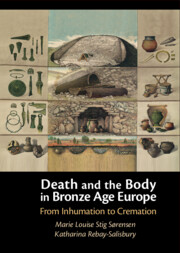Book contents
- Death and the Body in Bronze Age Europe
- Death and the Body in Bronze Age Europe
- Copyright page
- Contents
- Figures
- Tables
- Acknowledgements
- One Introduction
- Two A Brief History of Urns, Urnfields, and Burial in the Urnfield Culture
- Three Theoretical Framework
- Four The Bronze Age
- Five The Changing Bronze Age Body
- Six The Treatment of the Body
- Seven The Construction of Graves
- Eight After the Burial
- Nine Conclusions
- References
- Index
Six - The Treatment of the Body
Compatibility and Divergence
Published online by Cambridge University Press: 22 December 2022
- Death and the Body in Bronze Age Europe
- Death and the Body in Bronze Age Europe
- Copyright page
- Contents
- Figures
- Tables
- Acknowledgements
- One Introduction
- Two A Brief History of Urns, Urnfields, and Burial in the Urnfield Culture
- Three Theoretical Framework
- Four The Bronze Age
- Five The Changing Bronze Age Body
- Six The Treatment of the Body
- Seven The Construction of Graves
- Eight After the Burial
- Nine Conclusions
- References
- Index
Summary
Contrary to the expectation that cremation burials must be motivated by either the desire to reduce the body to some kind of essence or the wish to erase it, our investigation of the cremation burials that appeared and became common in different parts of Europe during the Middle Bronze Age suggests different motivations and reveals substantial variation. In particular, the range of activities that took place after the cremation shows clearly that the cremation was not usually the final stage of this ritual and the handling of the dead body. Rather, this stage was followed by different kinds of actions that involved manipulation of the remains, presumably as part of a long chain of articulations about what these remains were or were about. In the following, we shall outline some of the main practices observed and demonstrate their conspicuous concern with the physicality of the body. We show how cremations during the transitional period, when a normative understanding of cremation burials was being formed, implied a distinctly different internal logic and way of reasoning than that underwriting, for example, Hindu cremations or modern European ones. We argue that this was strongly influenced by contemporary perceptions of the body. Furthermore, we suggest that the wide-ranging variation and ‘experimentation’ show that beliefs or body ontologies when it came to cremation were not immediately fixed but for a couple of generations were in the process of becoming formulated. It was only after a while, something like the lifetime of a few generations, that a normative understanding of the status of the body in cremation burials had been established. It is this duration that we defined as the transitional period in Chapter 1.
- Type
- Chapter
- Information
- Death and the Body in Bronze Age EuropeFrom Inhumation to Cremation, pp. 113 - 148Publisher: Cambridge University PressPrint publication year: 2023



